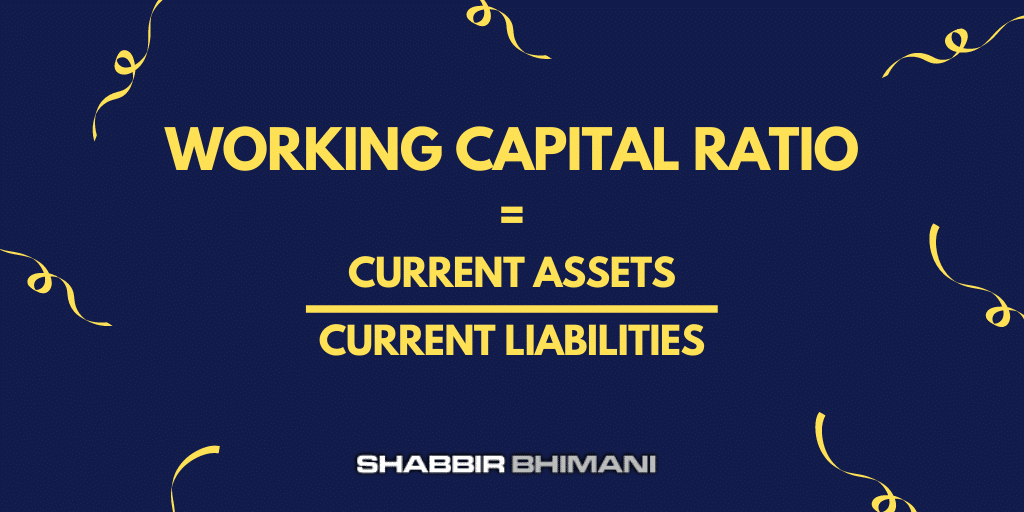What is the working capital cycle or days and why it is critical to invest in companies with low working capital requirements?
Working Capital is an indicator of the short-term financial health of a company. So it measures the overall efficiency of the business and the management.
Working Capital is the capital one needs in the short term. So the calculation is to subtract the current liabilities (one needs to pay in a short-term) from the current assets (one will get paid for in the short-term).
Working Capital = Current Assets – Current Liabilities
The ratio of the current assets to the current liabilities is an indicator of how well the company has funds to cover its short term liabilities using the current assets.
In accounting terms, the Current Asset is the available cash. Current Liabilities refer to the amount one has to pay.
Working Capital indicates the efficiency of the management to manage the day-to-day activities like managing the inventory, cash, accounts payable, accounts receivable, etc.
Working Capital Example
Suppose a company is ABC ltd that manufactures bikes.
So it will require cash to purchase raw material from suppliers. Again, the suppliers may not be needed to pay the same day. Let’s assume the supplier offers credit to the company for a month.
The bikes are manufactured, and the company will receive cash by selling them to the customers.
So, the difference between the payment one will receive by selling, and one needs to pay is the working capital.
Again, one may assume the difference is profit because it is the selling price less than the cost price. However, let me explain in detail to help you understand it better.
The difference is generally the profit. However, there isn’t an ongoing cost of production, and the company doesn’t sell directly to the customers.
The company ABC has to keep on producing the bikes, or else it will disrupt the supply chain. Similarly, the seller is not directly paying the company, but the retailer who interns may pay the distributor who then pays the company. Each one will have a time delay before one needs to make the payment for the product, much like the company ABC.
Assume the company can get the bike ready from the raw materials in 10 days. Then it is transported in 10 more days to the state-distributor, which in turn makes sure the bikes reach the retail shop.
The retailer and distributor get the bike but may need to pay for it within a month each.
The customer pays the retailer for the bike. The retailer then pays the distributor after a month. So now the distributor pays the company in a month.
- A month of credit for the distributor
- A month credit for the retailer
- 10 Days of Manufacturing.
- 10 Days of transportation.
Now the company ABC will receive the payment in 2 months and 20 days. However, it needs to pay the money for the raw material in a month.
Moreover, the company also needs to pay rent, salary, etc.
Why Working Capital Is Very Important when Investing?
In our example, if ABC Ltd wants to manufacture more and more bikes, it will require more and more working capital.
However, if ABC Ltd can get a credit of 3 months, the requirement for Working capital reduces considerably.
On the other side, ABC Ltd can reduce the payment time from the distributor or retailers for a better price. It may impact the margins slightly but will save on the finance cost for the working capital.
On the flip side, for more distributor incentives, the retailer credit can be by the distributor instead of by the company.
So Working Capital requirements does represent how efficiently the company is operating on a day to day basis.
The working capital is a very early indicator if the company can manage its operations with efficiency or not. Will the company be able to serve its short term expenses or not?
If short term expenses aren’t being services, sooner, the company will have issues serving long-term debts.
Working Capital Days
In our example of ABC Ltd, the company requires ten days to manufacture the bikes. It gets the money back from sales in 70 days. However, it has to pay for the raw material in 30 days.
The number of days the money rotates is 10+70-30 = 50 days.
So working capital days for the company is 50 days.
Working Capital Cycle
Every company has a cycle of converting raw material into a product and then selling it.
The process requires time.
The money takes time to come back to the company, along with the profits.
The entire process of when the money comes back into the company is known as the working capital cycle.
Final Thoughts
A higher working capital cycle means the company may need to take short-term debts, and that can impact the performance. Moreover, short term debts can come at a much higher interest rate as well.
So one should opt to invest in a company that has a lower working capital cycle.





Some companies shows -ve working capital days. what it means?
I want to express my gratitude for the time and effort you put into producing this post. I’m hopeful that you’ll continue to produce your best work in the future as well